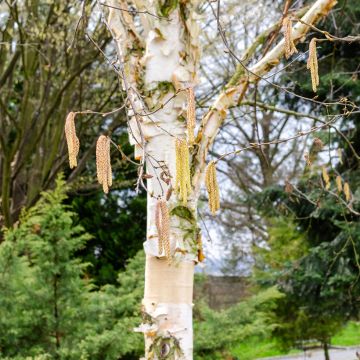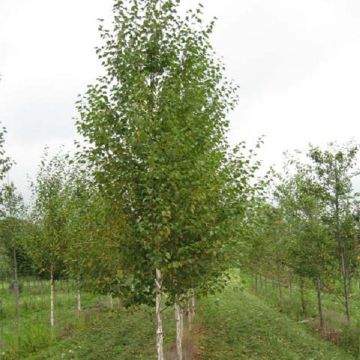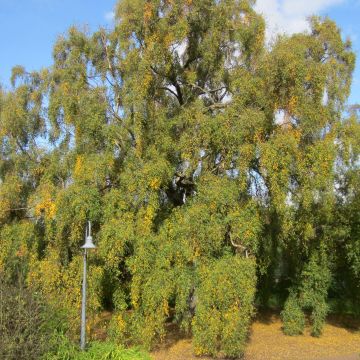

Betula nigra - Birch
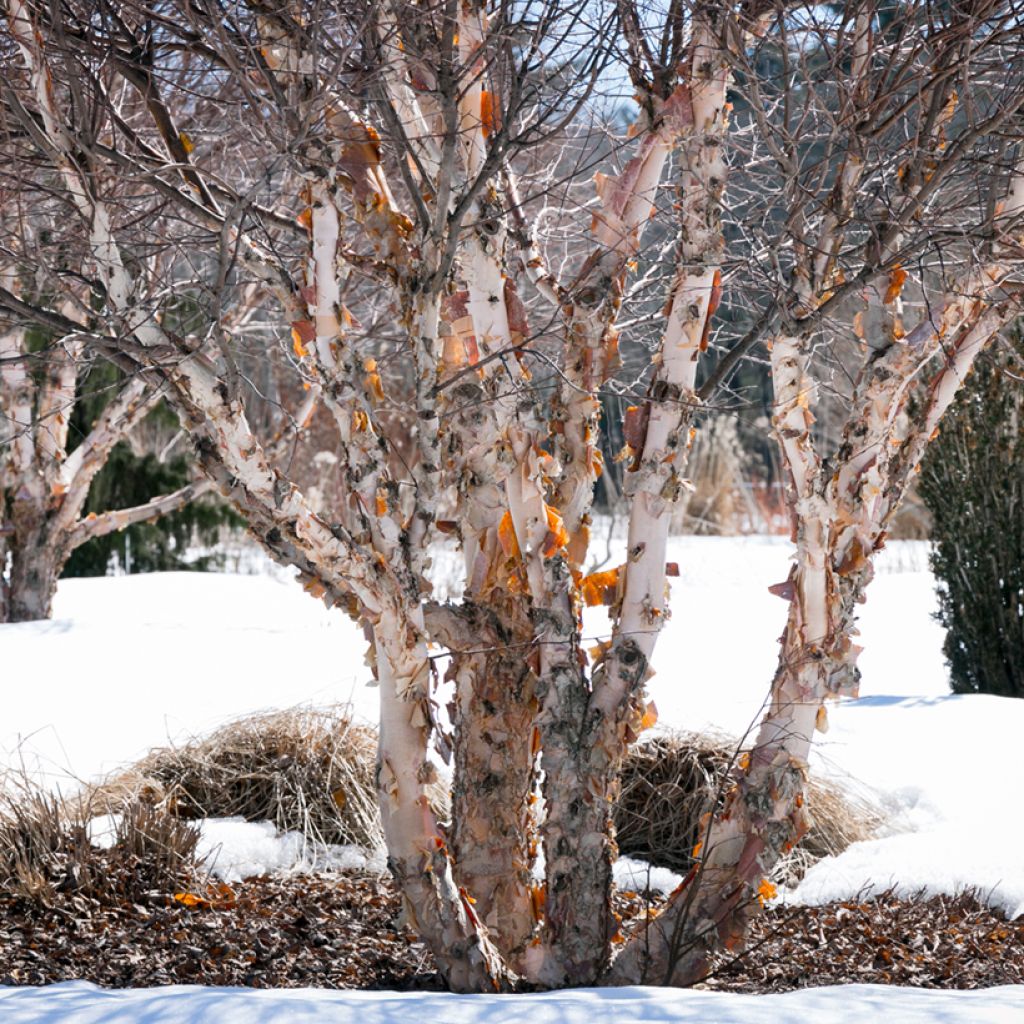

Betula nigra - Birch


Betula nigra - Birch


Betula nigra - Birch
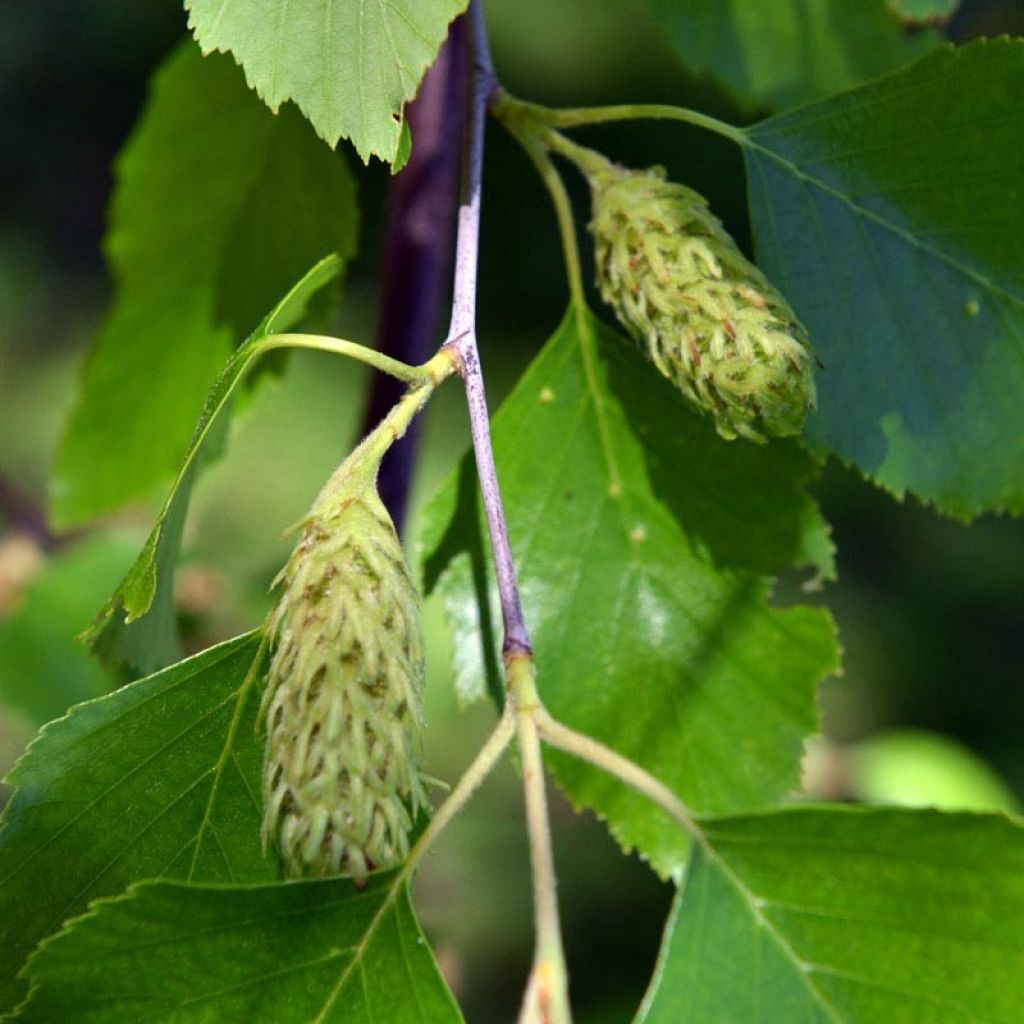

Betula nigra - Birch


Betula nigra - Birch
Betula nigra - Birch
Betula nigra
Black Birch, River Birch, Water Birch
Why not try an alternative variety in stock?
View all →This plant carries a 24 months recovery warranty
More information
We guarantee the quality of our plants for a full growing cycle, and will replace at our expense any plant that fails to recover under normal climatic and planting conditions.
From €5.90 for pickup delivery and €6.90 for home delivery
Express home delivery from €8.90.
Does this plant fit my garden?
Set up your Plantfit profile →
Description
Betula nigra or Black Birch is a very hardy, deciduous tree, often with multiple trunks, native to the plains and marshes of the eastern United States. It is decorative all year round with its highly textured bark, initially reddish-brown turning black or grey-white, fissured and peeling off in strips that curl up, revealing a smooth, grey-orange trunk! Fast-growing and medium sized, it has an airy, rounded habit and twisted, irregular, slightly weeping branches that look wonderful when planted alone or in groups in large spaces. Its light, glossy deep green foliage quickly emerges and turns golden yellow, illuminating autumn days. Thriving in wet environments, it flourishes in sun or partial shade and in soil that is moist to dry, neutral to acid.
The Black birch, or Betula nigra, is a deciduous tree native to warm regions in the southeastern United States. In nature, it is found along rivers and swamps, although it can tolerate much drier conditions. It is also known as the "River birch".
It is a medium-sized tree, reaching 15 m (49 ft 2 in) in height and 10 m (32 ft 10 in) in spread at maturity, growing rapidly, often from multiple trunks. Its is naturally rounded and erratic. It develops an elegant, twisted and irregular framework with unevenly arranged branches that divide into slender, slightly weeping branches. The trunks of juvenile specimens are reddish-brown, until a quite advanced age. The bark of old trees, which is dark brown or grey-white, is deeply furrowed at the base and peels off in large strips, revealing a new, much lighter, grey-orange bark. The young branches are reddish-brown and dotted with dark lenticels. Its shiny, deep green, deciduous foliage, hairy on the underside, 8 cm (3.1 in) wide, is diamond-shaped with doubly toothed margins. The leaves appear early in the year, forming a semi-open, light canopy that turns golden-yellow in autumn. In April, it produces masses of yellow-brown, pendulous, male catkin-like flowers reaching up to 8 cm (3.1 in) in length
The black birch is a fairly tolerant plant when it comes to soil, as long as it is not too dry or chalky. It thrives in partial shade, and its slender form and moderate size make it a great addition to medium-sized gardens. As a street tree, it can also be planted in small groups of 3 specimens or placed in the centre of a bed, surrounded by ground-cover perennials such as lungworts, Trachystemon orientalis, or a carpet of wood anemones. It lends itself to superb combinations with other plants that are particularly striking in winter, such as Cornus with its multicoloured-bark, or fragrant, winter-flowering Hamamelis and Sarcococca. Its autumn foliage can be combined with that of Nyssa sylvatica in boggy soil or at the edge of a pond, or with that of deciduous viburnums or Parrotia persica in drier soil.
Report an error about the product description
Betula nigra - Birch in pictures
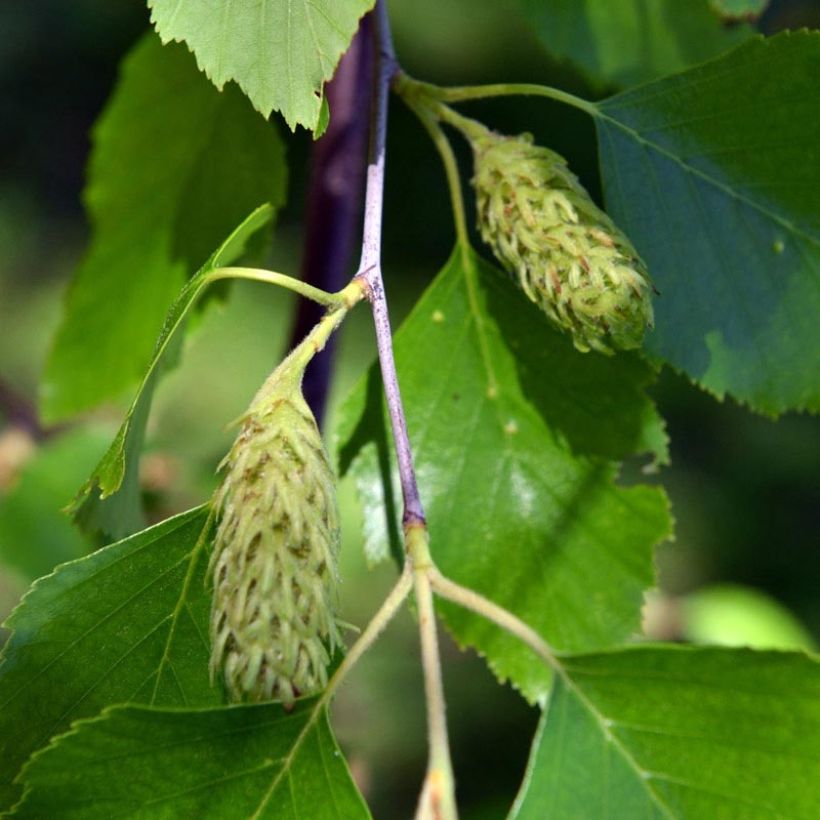





Plant habit
Flowering
Foliage
Safety measures
Botanical data
Betula
nigra
Betulaceae
Black Birch, River Birch, Water Birch
Cultivar or hybrid
atteinterespiratoire
Cette plante peut entraîner des symptômes allergiques.
Evitez de la planter si vous ou vos proches souffrez de rhinite saisonnière ("rhume des foins").
Davantage d'informations sur https://plantes-risque.info
Other Betula - Birch tree
Planting and care
Very easy to grow in soil that is not too dry or too chalky (even clayey, heavy, waterlogged, poorly drained and boggy), the black birch requires little maintenance, apart from regular watering and the use of mulch in the event of prolonged drought. It should preferably be planted in a moist, fertile soil, where it will be more beautiful and grow faster, but it will also do well in slightly chalky or sandy, occasionally dry soil, in full sun or partial shade. Pruning is not necessary. The plant is remarkably resistant to pollution, diseases or parasites that usually attack birch trees.
Planting period
Intended location
Care
This item has not been reviewed yet - be the first to leave a review about it.
Haven't found what you were looking for?
Hardiness is the lowest winter temperature a plant can endure without suffering serious damage or even dying. However, hardiness is affected by location (a sheltered area, such as a patio), protection (winter cover) and soil type (hardiness is improved by well-drained soil).

Photo Sharing Terms & Conditions
In order to encourage gardeners to interact and share their experiences, Promesse de fleurs offers various media enabling content to be uploaded onto its Site - in particular via the ‘Photo sharing’ module.
The User agrees to refrain from:
- Posting any content that is illegal, prejudicial, insulting, racist, inciteful to hatred, revisionist, contrary to public decency, that infringes on privacy or on the privacy rights of third parties, in particular the publicity rights of persons and goods, intellectual property rights, or the right to privacy.
- Submitting content on behalf of a third party;
- Impersonate the identity of a third party and/or publish any personal information about a third party;
In general, the User undertakes to refrain from any unethical behaviour.
All Content (in particular text, comments, files, images, photos, videos, creative works, etc.), which may be subject to property or intellectual property rights, image or other private rights, shall remain the property of the User, subject to the limited rights granted by the terms of the licence granted by Promesse de fleurs as stated below. Users are at liberty to publish or not to publish such Content on the Site, notably via the ‘Photo Sharing’ facility, and accept that this Content shall be made public and freely accessible, notably on the Internet.
Users further acknowledge, undertake to have ,and guarantee that they hold all necessary rights and permissions to publish such material on the Site, in particular with regard to the legislation in force pertaining to any privacy, property, intellectual property, image, or contractual rights, or rights of any other nature. By publishing such Content on the Site, Users acknowledge accepting full liability as publishers of the Content within the meaning of the law, and grant Promesse de fleurs, free of charge, an inclusive, worldwide licence for the said Content for the entire duration of its publication, including all reproduction, representation, up/downloading, displaying, performing, transmission, and storage rights.
Users also grant permission for their name to be linked to the Content and accept that this link may not always be made available.
By engaging in posting material, Users consent to their Content becoming automatically accessible on the Internet, in particular on other sites and/or blogs and/or web pages of the Promesse de fleurs site, including in particular social pages and the Promesse de fleurs catalogue.
Users may secure the removal of entrusted content free of charge by issuing a simple request via our contact form.
The flowering period indicated on our website applies to countries and regions located in USDA zone 8 (France, the United Kingdom, Ireland, the Netherlands, etc.)
It will vary according to where you live:
- In zones 9 to 10 (Italy, Spain, Greece, etc.), flowering will occur about 2 to 4 weeks earlier.
- In zones 6 to 7 (Germany, Poland, Slovenia, and lower mountainous regions), flowering will be delayed by 2 to 3 weeks.
- In zone 5 (Central Europe, Scandinavia), blooming will be delayed by 3 to 5 weeks.
In temperate climates, pruning of spring-flowering shrubs (forsythia, spireas, etc.) should be done just after flowering.
Pruning of summer-flowering shrubs (Indian Lilac, Perovskia, etc.) can be done in winter or spring.
In cold regions as well as with frost-sensitive plants, avoid pruning too early when severe frosts may still occur.
The planting period indicated on our website applies to countries and regions located in USDA zone 8 (France, United Kingdom, Ireland, Netherlands).
It will vary according to where you live:
- In Mediterranean zones (Marseille, Madrid, Milan, etc.), autumn and winter are the best planting periods.
- In continental zones (Strasbourg, Munich, Vienna, etc.), delay planting by 2 to 3 weeks in spring and bring it forward by 2 to 4 weeks in autumn.
- In mountainous regions (the Alps, Pyrenees, Carpathians, etc.), it is best to plant in late spring (May-June) or late summer (August-September).
The harvesting period indicated on our website applies to countries and regions in USDA zone 8 (France, England, Ireland, the Netherlands).
In colder areas (Scandinavia, Poland, Austria...) fruit and vegetable harvests are likely to be delayed by 3-4 weeks.
In warmer areas (Italy, Spain, Greece, etc.), harvesting will probably take place earlier, depending on weather conditions.
The sowing periods indicated on our website apply to countries and regions within USDA Zone 8 (France, UK, Ireland, Netherlands).
In colder areas (Scandinavia, Poland, Austria...), delay any outdoor sowing by 3-4 weeks, or sow under glass.
In warmer climes (Italy, Spain, Greece, etc.), bring outdoor sowing forward by a few weeks.



































